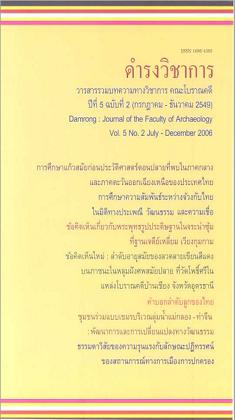EARLY MAKARA TORANA IN INDIAN ART
Keywords:
ศิลปะอินเดีย, มกร, โตรณะAbstract
Composed of two Makaras disgorging the curvilinear frame punctuated by a medallion, Makara Torana is a motif especially meant for the niche or the doorway. This motif originated and is frequently found as a decoration for South Indian temples, despite having been found both in North Indian architecture and in the early stage of Cambodian architecture also. The lksvaku art of Nagarjunakonda, Vakataka art, Pallava art and Calukya art of Badami are amongst the earliest schools in which this kind of motif was initiated and developed.
The genesis of Makara Rorana is possibly related to the motif “the garland-bearers” that beautified the lintel of the railing encircled Stupas of Amaravati school. A lintel of Nagarjunakonda Museum, with the motif of the garland terminated by two Makaras and punctuated by several medallions, supports this theory.
In the early period of Pallava and of Calukya of Badami, the motif became more rigid, regurarly with two Makaras disgorging two curvilinear frames punctuated by a medallion under which there is a tassel. The examples of this kind of Makara Torana can be studied from Draupati Ratha at Mamallapuram and Malegitti Shivalaya at Badami. This style of Makara Torana is possibly the prototype for the famous motif of lintels in the earliest stage of the Cambodian art.
During the later period, the motif of Makara Torana become more vivid and various. Considered from Kailashanath at Kancipuram, there are numerous styles of Makara Torana co-existing in the same monument, For some of them, the amount of Makara becomes more than two, others are filled with other sculptures, like Simha and human figures. All of them, however, are without medallionsm being different from those of Draupati Ratha.
Vurupaksha of Pattadakal, which is supposed to be inspired by Kailashanath of Kancipuram, exhibits the most complicated system of Makara Torana in early South Indian art. Makara Torana at Virupaksha comprises two different types co-=existing in the same monument, the original-style (with medallion) and the Kailashanath’s style (without medallion). While the former is meant for the door of the sanctum, the latter is conceived for the outside niches.
The study on the development of Makara Torana in early South Indian art benefits studies on the style of early Southeast Asian art, especially the study on the earliest stage of Cambodian art.
References
Harle, J.C. The Art and Architecture of the Indian Subcontinent. Yale University Press,1994.
Huntington, S.L. The Art of Ancient India : Buddhist Hindu Jain. New York Weatherhill, 1999.
Sivaramamurti, C. The Art of India. New York : Harry N Abram, 1977.
Downloads
Issue
Section
License
บทความนี้เป็นผลงานของข้าพเจ้าแต่เพียงผู้เดียว และ/หรือเป็นผลงานของข้าพเจ้าและผู้ร่วมงาน ตามชื่อที่ระบุในบทความจริง และเป็นผลงานที่มิได้ถูกนำเสนอหรือตีพิมพ์ที่ใดมาก่อน


